The AMD Radeon VII Review: An Unexpected Shot At The High-End
by Nate Oh on February 7, 2019 9:00 AM ESTProfessional Visualization and Rendering
With AMD strongly pushing the Radeon VII as a prosumer content creation card, it behooves us to look at rendering, CAD, and professional visualization performance. However, accurate and applicable benchmarks for this field are not so easy to find, especially since performance is highly dependent on workflow and proprietary licensed ISV software. Given AnandTech’s audience, which often includes engineers using these applications in critical production environments, our goal is to provide the most relevant metrics. However, as Ian has discussed previously, the route to the most accurate workstation benchmarking for professional applications is in the hands of ISVs, who are at best blasé and more typically negative about providing access, even at the prospect of lending limited software licenses in return for ongoing discussion and third-party benchmark data of their software.
Those caveats in mind, the next best thing for evaluating overall GPU workstation performance is the venerable SPECviewperf, recently updated to version 13. Separated into ‘viewsets,’ which are a group of application-specific workloads derived from real-world datasets, SPECviewperf has been a longstanding suite for generalized workstation/CAD GPU performance. For SPECviewperf 13, the viewsets are based on:
- Autodesk 3ds Max 2016 (Nitrous DX11 driver)
- Dassault Systèmes CATIA V6 R2012
- PTC Creo 3 & Creo 4
- Geosurvey software, with workloads based on rendering techniques utilized by the open-source OpendTect seismic visualization application
- Autodesk Maya 2017
- Radiological (i.e. CT, MRI scans) rendering, with workloads using the Tuvok rendering core of the ImageVis3D volume visualization application
- Autodesk Showcase 2013
- Siemens NX 8.0
- Dassault Systèmes Solidworks 2013 SP1
While we didn’t have time for complete benchmarking of video editing/production software such as Adobe Premiere Pro CC, we will be looking to include that in the future.
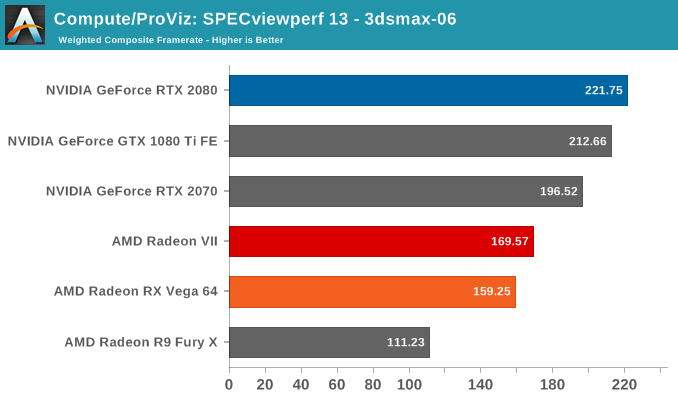
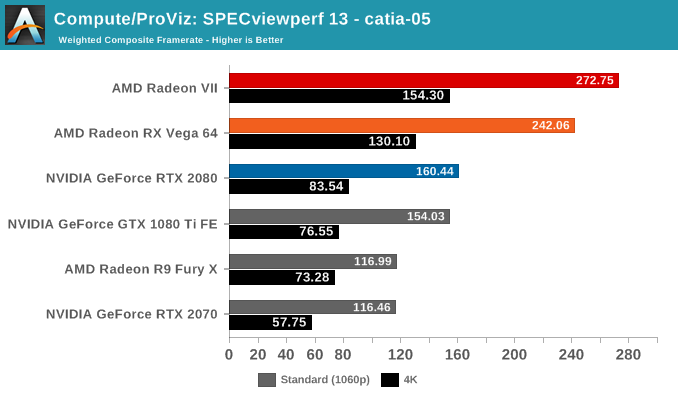

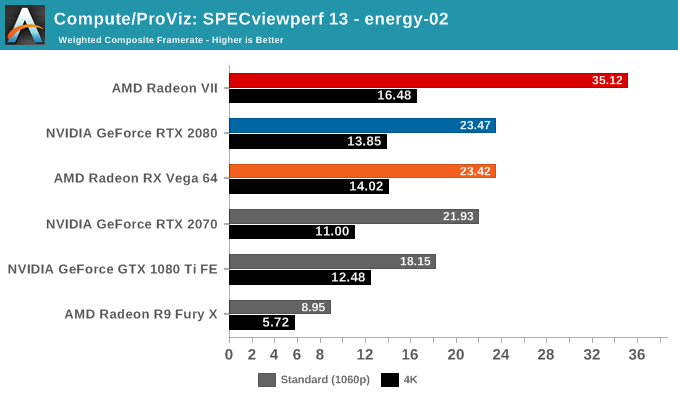
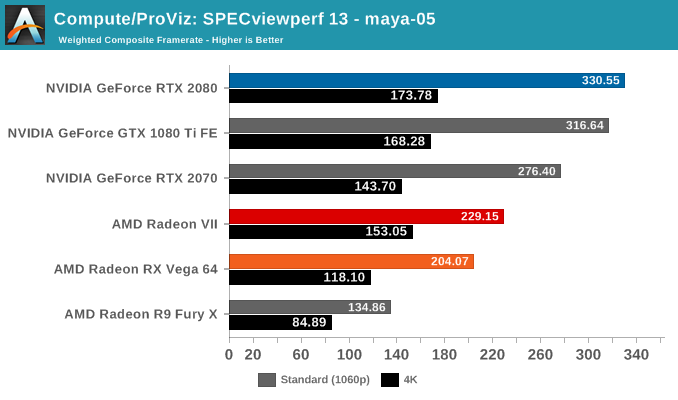
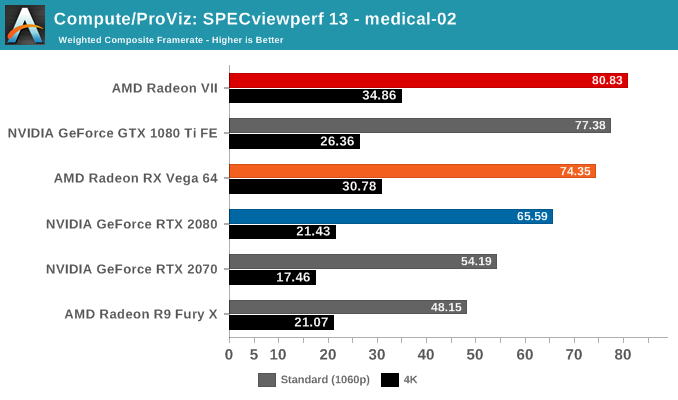
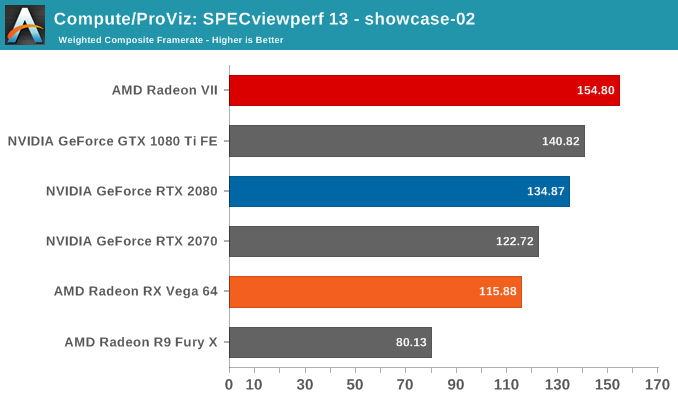
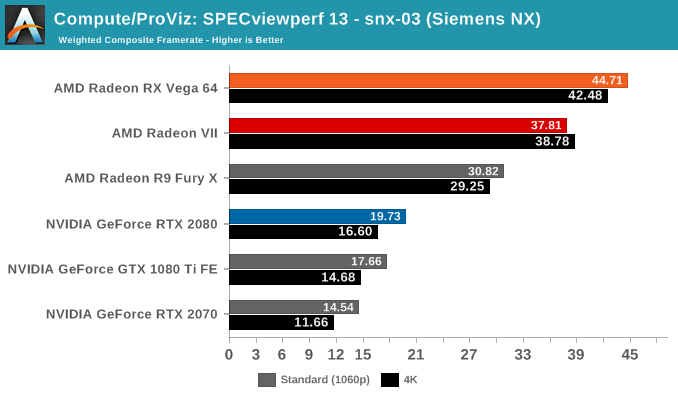
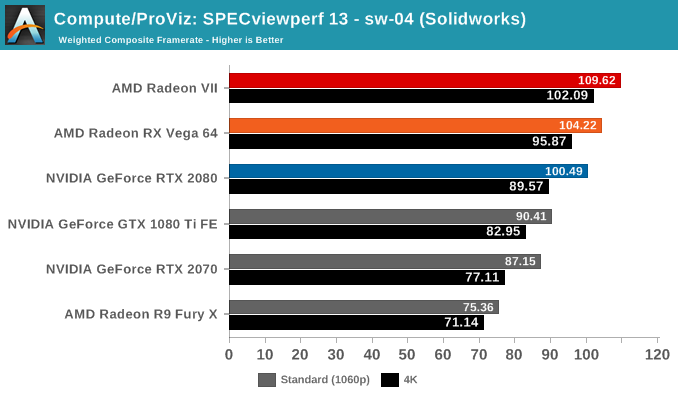
Looking over the results, it's clear that certain viewsets tend to perform better on one vendor's hardware than the other's. In those cases, the Radeon VII doesn't buck the trend, though in Siemens NX the lower performance is more likely than not related to driver maturity. In the reverse scenarios like in creo-02 or maya-05, the Radeon VII is in a similar spot, naturally ahead of the RX Vega 64 but behind the competing RTX and GTX cards. If anything, the results highlight the importance of software maturity for newer hardware, but there are definite signs of Vega 20 being a powerful workstation card. The caveat is that it doesn't seem to change the overall landscape for worksets that traditionally perform well on NVIDIA hardware.
Our next set of benchmarks look at rendering performance. To be clear, given the nature of ‘render wars’ as well as the adoption of CUDA, the featured render engines are not necessarily indicative of the overall GPU renderer landscape. Because we are looking at the Radeon VII, it’s not applicable to include some of the more popular renderers, such as Redshift and Octane, which are CUDA-only, and similarly the presence of Indigo Renderer helps as another datapoint even though it is less popular.


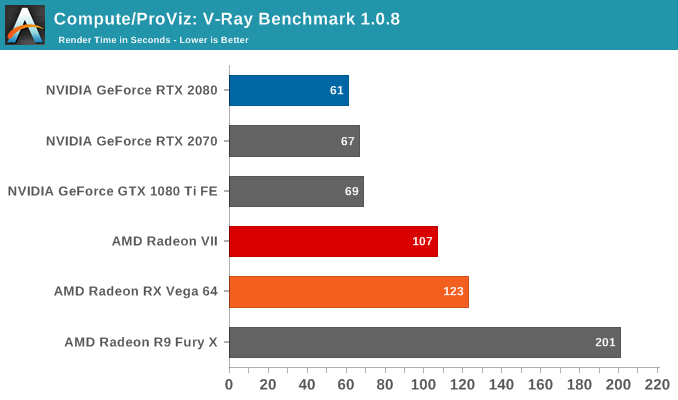

To note, official Blender releases have yet to incorporate CUDA 10, and so RTX 20 series cards are not officially supported.
V-RAY here is the only test that utilizes CUDA for NVIDIA cards, while the rest all use OpenCL. The results seem broadly similar to SPECviewperf, where the Radeon VII continues to excel at workloads where AMD hardware generally fare well.










289 Comments
View All Comments
just4U - Friday, February 8, 2019 - link
It's not a turkey at all.. it beats a Vega64 for around 30% ads 2x the ram (which is not really utilized yet) has a 3 fan design with Amd's top end shroud/block takes less power, runs cooler, and has the same characteristics which means Amd was generous on power so undervolting it without appreciable performance losses will be easy enough to do as will overclocking.For me that's a winner. I have blower 1080s and their very loud if I let them or run things at stock (i undervolt there to..) and I've seen how loud the Vega56/64 blowers can be.. this with the 3 fans? pfft.. way quieter.
Oxford Guy - Friday, February 8, 2019 - link
I think you should look at the data in this review because your analysis is way off.ballsystemlord - Thursday, February 7, 2019 - link
They are sold out! All the online retailers I checked have no Radeon VIIs! Unless you go to ebay and pay way too much.Oxford Guy - Thursday, February 7, 2019 - link
Overpriced underbaked vaporware? Never-coulda-happen.It's an ugly time to be a "serious" PC gamer.
ballsystemlord - Friday, February 15, 2019 - link
Well, it's been a week. They came into stock for about 5min.LogitechFan - Friday, February 8, 2019 - link
amdumb defense force in full denial mode, sorry, we can't hear you over the 55db noise level of the radeon VII ;)))))))))rukufe - Friday, February 8, 2019 - link
If you want to play with AI, you need tensorflow, and for a "server" card, at this price, it doesn't not makes sense to not support tensorflow. AI is everywhere today. this card is obsolete.gsalkin - Friday, February 8, 2019 - link
So is this too little too late? I'm bewildered that even at 7nm this card is pulling 300W of power and generating insane noise.It's also unfortunate that the rumor of 128 ROPs was bunk. These cards definitely have an imbalance in the CU to ROP ratio. Nvidia Titan Xp had 96 ROPs strapped to 3840 SPs but AMD is shipping a max of 64?
Oxford Guy - Friday, February 8, 2019 - link
"It's also unfortunate that the rumor of 128 ROPs was bunk."That rumor typifies the irrational thinking that plagues the gaming community. AMD isn't going to make the effort of changing the Instinct GPU to better suit gamers. It isn't and it hasn't.
dr.denton - Saturday, February 9, 2019 - link
I wonder, do people actually read and comprehend these articles? By now it should be obvious to everyone, that VII is not and was never supposed to be AMD's next generation of GPU. In fact, they always denied that Vega 7nm would make it into the consumer market - and for very good reason: they had Navi for that. Now that Navi is delayed, they need something for people to talk about - and talk about it we do.